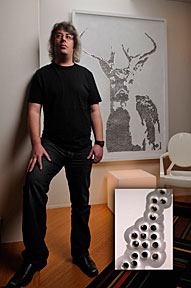Walt Creel is a revolutionary artist - or perhaps an artistic revolutionary. Instead of relying on paint or ink, he uses firearms to create images. His dot-matrix designs, composed of bullet holes in six-foot panels of painted metal, have gone viral on the Internet and attracted attention from Chinese and European media and prestigious American art journals. At UAB, however, the Web wonder is better known as an information-technology specialist for audio and video support.
 |
| Walt Creel is not your run-of-the-mill artist. Instead of paints or pencils, Creel uses firearms to create his images. |
What inspired you to use guns?
Creel: Being from Alabama, I am familiar with guns and wanted to incorporate them into art, but I did not want to photograph them, paint them or otherwise use the gun as an image. I took a canvas into the woods and shot at it from a multitude of angles; things really clicked when I got right up on the canvas and shot in a single-file line. Then I realized I could use the gun solely as a tool to create my work.
What led you to focus on animal images?
Creel: My first experiments were on hunting land, and animal images seemed natural. The deer was the first to jump to mind. The opossum is the most divisive of the images; people either love it or react as if they had found an opossum in their own home. I was happy with how cute the bunny turned out; it's satisfying to get an "aww, how adorable" reaction to an image shot with a gun.
How do people respond?
Creel: Enthusiastically. Pro-gun people see my work as a sort of celebration of firearms; those who are anti-gun see it as an ironic protest. I have heard more than one person call my work the only good use of a gun. I try to leave any message up to the viewer - I want the art to speak to them on its own. I call the series "De-weaponizing the Gun" simply because the gun is the tool used to create the art.
What do coworkers think about your world-renowned art?
Creel: They all like my work and have been very supportive. I think they have only caught glimpses of how my art is being received. I have had journalists and fans from around the world contact me, and I have seen the newspapers and blogs, but viewing it all through the Internet seems distant. It doesn't feel quite real.
What is your process? How long does it take?
Creel: The first image, the deer, definitely took the longest because I had to figure out what I was doing, the materials to use, which ammunition jammed the least and how closely I could place the bullets without destroying the piece. From the initial experiments until completion was almost a year. It was such a dramatic experience that I couldn't think about doing another one for about another year. Due to the high cost of making one of these pieces, the size of the material and the time it takes to prepare it, plus shooting it 5,000 times, it is rare for me to make more than one a year. Last year I worked on a piece during the summer. Standing in the heat all day with a very hot gun gets exhausting.
What materials do you use?
Creel: I quickly discovered that canvas was not going to hold up to repeated shots at point-blank range. Aluminum works well, but it has to be reinforced. I apply white paint to the surface; each bullet knocks off a little paint around each hole and really defines the image. The gun is a Ruger .22 rifle that my father gave me for Christmas.
Describe your project with the Coleman Center for the Arts.
Creel: The Coleman Center is a great cultural resource located in York, Ala., that brings well-known artists from around the country to work with the community. I displayed my work in their gallery and held two special events. At the first, I demonstrated the process I use to make my work. The second was a closing reception and paintball event. I took a sheet of wood with the same dimensions as the deer, painted it white, and then laid a cardboard stencil resembling the deer over it. Everyone took turns shooting it with multicolored paintballs until it-and everything around it-was fully covered. We all had a great time.
What's next for your art?
Creel: I have designed a new body of works with different subject matter that I will make using the same technique. I am very excited about this group.
More information
Check out more pieces on Walt Creel's Web site, www.waltcreel.com.
-UAB Magazine